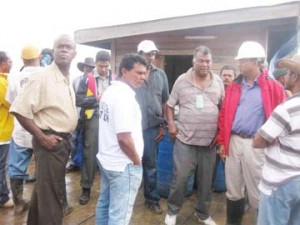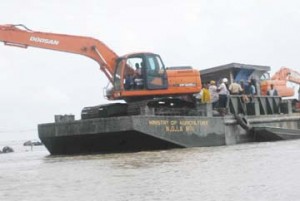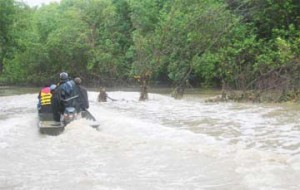Residents of Abary Creek who were invited to inspect the dredging of the mouth of the creek on Wednesday expressed satisfaction at the job and are relieved that drainage in the area would finally be improved.

The work which commenced last week Thursday and is expected to last another two weeks is being overseen by the National Drainage & Irrigation Authority (NDIA).
Minister of Agriculture, Robert Persaud told the media that contractors had estimated the job to cost $125M but government purchased the pontoon and two long-boom excavators at a cost of $90M.
Work is also being done to empolder around the residents’ homes and government also intends to build up the land for the cattle farmers.
The minister said too that the dredging was a “critical intervention for the current rainy season” and that for too long the farmers were vulnerable. He hopes that the work would bring “preparedness relief” and said that there is also rapid siltation of all of the other outfalls.
Accompanying the minister on the visit were Chief Executive Officer of the NDIA Lionel Wordsworth, General Manager of the Mahaica-Mahaicony-Abary (MMA) scheme Aubrey Charles, chairman of the MMA board Rudolph Gajraj and Chairman of Region Five Harrinarine Baldeo.
Residents told Stabroek News that they “see a lot of improvement already but we want the work to continue towards the public road” where the “trees are closing in and the creek is becoming narrow.”
Asked about that, Minister Persaud informed this newspaper that “during the high tide we would see how much [trees] can be removed.”
A former Environmental Officer attached to MMA, Rabindranauth Saywack told this newspaper that “to maintain effective flow, tree stumps [that fell] midstream must be removed and it is better to do so during the low tide.”
With regards to the trees growing in a section of the creek, Saywack said “they can’t do anything about bank-side vegetation growing (inwards) or it would increase erosion on the banks and cause slippage.”
He commended the government for the “good job but it took a long time to come. If it was done before the last flood residents would not have suffered so much loss.”
The residents and farmers had asked President Bharrat Jagdeo for the mouth of the creek to be dredged when he visited the creek during the rainy season in January saying that the floodwaters take a long time to recede.

They had told the president that last year March the area was dredged with a short-boom excavator and although the water started to drain within four days an excavator with a longer boom would have been more effective.
The president then gave instructions for the dredging to continue and residents are pleased that it has finally commenced. Following the president’s visit the residents went to the mouth of the creek in February to check the extent of siltation.
They had told this newspaper that the creek was blocked in five places – marked by tree stumps – and that this contributed to he clogging of the river and reduced flow downstream. They had pleaded for it to be cleared before the next rainy season begins because they were tired of losing their crops and livestock to a “disaster which can be avoided.”
A resident of the creek, Mahase Prahalad and another farmer had jumped out of the boats to prove how badly clogged it was and stood in waist-deep water.

A proposal had been submitted with three dredging options to the Ministry of Agriculture for approval. Meanwhile feasibility studies have been completed and government is waiting on the Venezuelans to dredge the river at an estimated cost of $50M.





